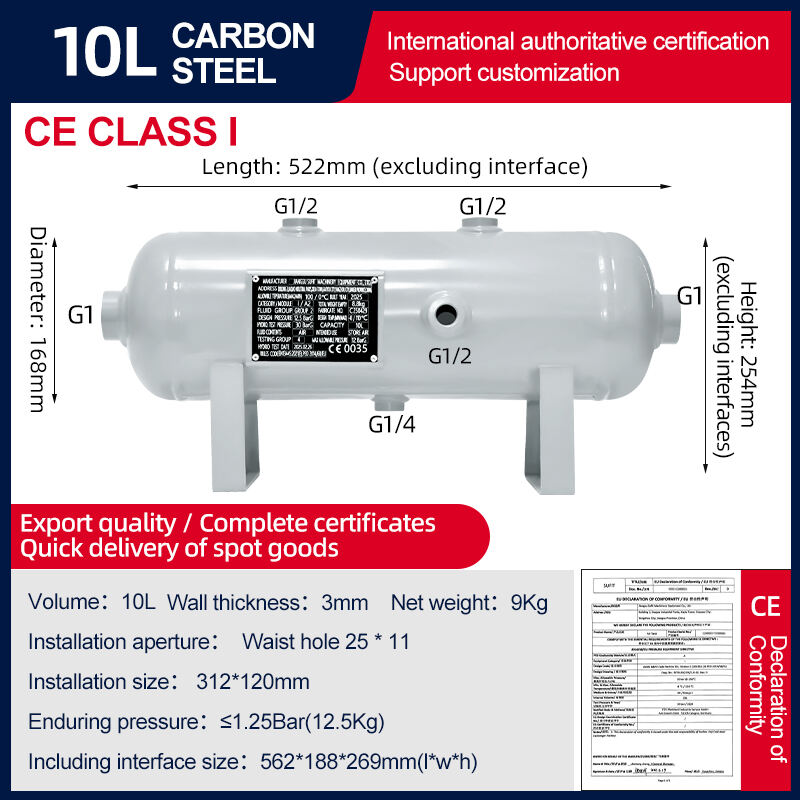كيفية تصنيف خزانات الهواء وفقًا لمعايير CE؟ الوحدة A1، A2، والوحدة G.
في المقال السابق، علمنا أن خزانات الهواء الحاصلة على شهادة CE تكون أكثر تكلفة بكثير مقارنة بخزانات الهواء العادية، وتُصنف خزانات الهواء الحاصلة على شهادة CE إلى وحدات مختلفة وفقًا لفئات المخاطر: A1، A2 وG.
أثناء التواصل مع المصنع، خزان الهواء يجب على العملاء أيضًا فهم المبدأ الأساسي للتصنيف:
تعتمد الفئات بشكل أساسي على معلمتين:
السعة (V): تقاس بوحدة اللتر (L)
الضغط الأقصى (PS): تقاس بوحدة البار (bar)
إذا كان ناتج ضرب سعة الخزان في الضغط الأقصى (V*PS) أقل من 200، فإنه ينتمي إلى الوحدة A1؛
إذا كان ناتج ضرب سعة الخزان في الضغط الأقصى (V*PS) بين 200 و1000، فإنه ينتمي إلى الفئة A1؛
وإذا كان الناتج أكثر من 1000، فإنه يدخل ضمن الوحدة G.
على سبيل المثال، خزان هواء سعة 20 لترًا بضغط 8 بار، يُصنف حسب وضعية CE A1؛ أما خزان الهواء سعة 100 لتر وضغط 8 بار، فهو يُصنف حسب وضعية CE A2؛ وإذا كان نفس الخزان سعة 100 لتر ولكن بضغط 12.5 بار، فهو يُصنف حسب وضعية CE G.
إذًا ما الفرق بين وضعيات A1 وA2 وG؟
وضعية A1 : ضبط الجودة الداخلي + التحقق المراقب، لتصنيع خزانات الهواء بشكل جماعي ضمن الفئة الثانية من قانون المعدات تحت الضغط (PED)
في وضعية A1، تقوم مصنع خزانات هواء الشركة المصنعة بإنشاء وتنفيذ نظام ضبط جودة داخلي. ولا يقوم الجهاز المعتمد بمراجعة النظام الكامل للجودة، بل يراقب الشركة المصنعة لخزانات الهواء من خلال أخذ عينات أو فحص فردي لخزانات تخزين الهواء المنتجة للتحقق من المطابقة. وتُستخدم هذه الوضعية في الإنتاج الجماعي لخزانات الهواء ذات المخاطر المنخفضة، مع مستوى أقل من تدخل الجهاز المعتمد مقارنةً بالوضعية A2.
وضعية A2 :ضبط الجودة الداخلي + التفتيشات غير المجدولة، للإنتاج الجماعي لخزانات الهواء ضمن الفئة الثالثة من قانون المعدات تحت الضغط (PED)
في الوحدة A2، يقوم مصنعو خزانات الهواء أيضًا بإنشاء وتنفيذ نظام داخلي لمراقبة الجودة، ولكن تُجري الهيئات المعتمدة عمليات تفتيش مفاجئة وتقوم باختبارات ضرورية لخزانات الهواء في مستودع المصنع أو في السوق. يخلق هذا عدم اليقين ضغطًا مستمرًا على مصنعي خزانات الهواء للحفاظ على نفس المعايير العالية للجودة مع كل دفعة. توفر الهيئات المعتمدة رقابة أقوى مقارنة بالوحدة A1
الوحدة G : التحقق من الوحدة
في هذه الوحدة، يقوم الهيئة المعتمدة بفحص وتقييم كل خزان هواء على حدة. يتم مراجعة جميع الوثائق الفنية الخاصة بالخزان (حسابات التصميم، شهادات المواد، وثائق العمليات، إلخ). تقوم الهيئة المعتمدة باختبار التحقق النهائي (عادةً اختبار تمدد مائي) على خزان تخزين الهواء فقط بعد اجتياز جميع نقاط الفحص، تصدر الهيئة المعتمدة شهادة CE لهذا المنتج المحدد.
في المختصر:
إذا كنت تطلب خزان هواء كبير مخصص لمشروع معين، فاختر النموذج G.
إذا تم إنتاج خزانات تخزين الهواء متوسطة الخطورة بكميات كبيرة، فاختر النموذج A1 أو A2.
يُستخدم النموذج A1 للمعدات من الفئة الثانية الأقل خطورة ويتطلب رقابة قياسية نسبيًا.
يُستخدم النموذج A2 للمعدات من الفئة الثالثة الأكثر خطورة ويتطلب رقابة أكثر صرامة (تفتيشات غير مجدولة).
يحدد الوحدة العملية الاعتمادية والتكلفة والجدول الزمني، وبالتالي فإن اختيار الوحدة بالإضافة إلى تكلفة خزان الهواء نفسه يعتبر عاملًا مهمًا يسهم في اختلاف أسعار خزانات الهواء المعتمدة حسب المعيار الأوروبي (CE).
لا تتردد في التواصل مع YCZX لمعرفة المزيد من المعلومات حول خزانات الهواء المعتمدة حسب المعيار الأوروبي (CE).




